HCM development analyzed per breed (part 1)
Introduction
Feline Hypertrophic Cardiomyopathy (HCM) is a condition that causes the muscular walls of a cat’s heart to thicken, decreasing the heart’s efficiency which can lead to heart failure. HCM is the most commonly diagnosed cardiac disease in cats. HCM can also occur in other mammals and in humans, but for this article, we focus on the cats only.
There have been health programs set up for HCM for several feline breeds. Within this health program, the cats have been tested by approved cardiologists or radiologists, and their results are sent to Pawpeds for registration in the health database. This has been done for many years and thanks to the breeders that participated in the HCM health program, I was able to analyze the results that were gathered over the years.
HCM Health program
The Maine Coon was the first breed that had an HCM health program set up, starting from 1998. Then other breeds followed. In the table below you can see which year the program started. There are many more breeds that I have left out here, I’ve only picked the health programs that have more than 100 test results. This data shows the total results for the whole period of the Health program.
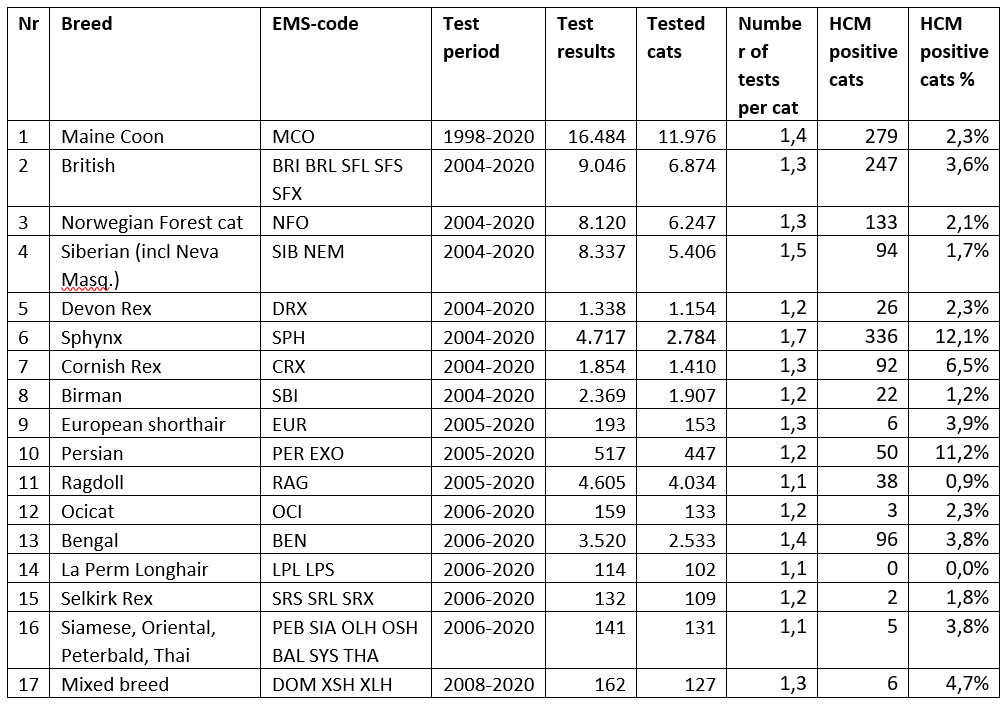
I have followed the PawPeds databases to get the group of EMS codes that are registered together in one database. For example, the Siberian and Neva Masquerade are registered together in one Pawpedsdatabase sharing the same health program.
The health program advises repeating the test at certain ages. As you can see by the 7th column, you can conclude that many cats have been tested more than once. Sphynx has the highest test frequency at 1,7 times per cat. The cats that had at least one diagnosis with HCM, is counted in the column HCM positive cats. A cat that has multiple results showing HCM, is counted only once. Results that were equivocal were not included in the HCM positive column, as equivocal is not HCM. PawPeds distinguishes different stages of HCM: mild, moderate, and severe. In the table, those were all counted as HCM (column 8).
You can see from the table that the Maine Coon has the most cats tested within the health program, almost 12.000 cats. Obviously the number of HCM diagnosed cats is, therefore, higher, but compared to the whole tested population, "only" 2,3% of the total tested cats got diagnosed with HCM.
Total cats with HCM diagnosis (1998-2020)
When you visualize the previous table, showing the total HCM cases compared to the total amount of cats tested, you will see the result in the chart below. This is the result of the total period of the health program, which for each breed has a different start date (shown in the table above).
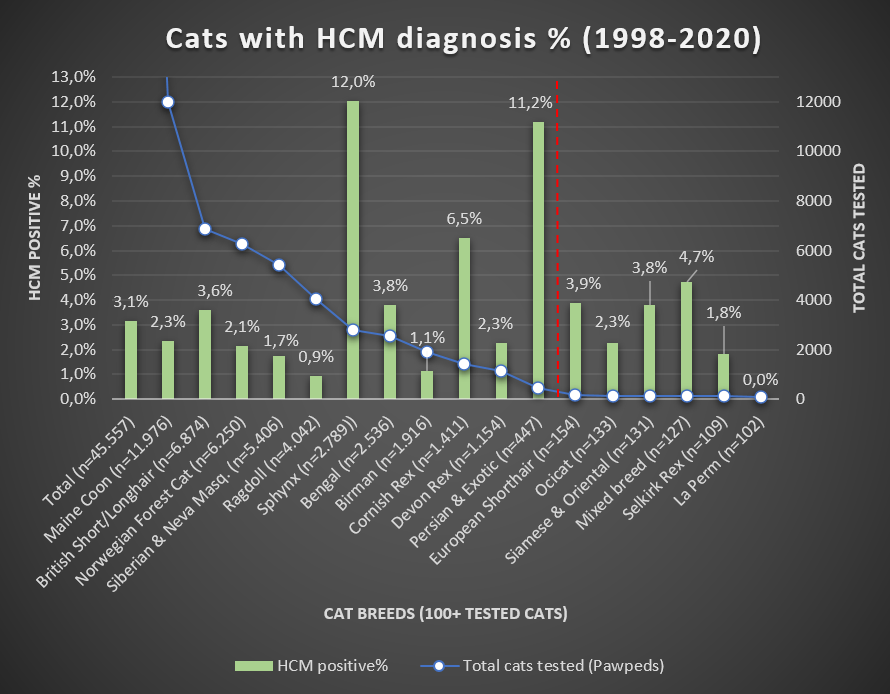
How to read this chart? The number of cats tested you see next to the breed's name (n=). For example, Siamese & Oriental have 131 cats tested with the health program in the period of 2006-2020. Of those 131 cats, 3,8% got diagnosed with HCM, which comes down to 5 cats. The blue line shows how many cats are tested. The bars are ordered by the number of test results. The lower the blue line, the less reliable the numbers will be. I have divided the chart with a red line. All the results for the breeds left from the red line I consider as reliable and the ones on the right are less reliable because there are not that many cats tested. For example, La Perm shows not one cat with HCM, but only 102 La Perm cats were tested within the health program during all those years. We cannot conclude that La Perm is a breed where HCM never occurs. The same can be said for other breeds that have less than 150 cats tested. Hopefully, when more breeders participate with the health program, we can make better conclusions for those breeds in the future.
When you count all the cat breeds together, 3,1% of the cats got diagnosed by HCM. Reading this chart you see that most HCM cases are found in the Sphynxinx and Persian & Exotic breeds, who stick out far above the others. The Ragdoll and Birman breeds seem to be on the safe side of the chart with less than 1% of cats diagnosed with HCM. Notice that this is the overall average result during the whole health program period, from start until March 2020. Nowadays this can look differently since we hope that the health program will improve the HCM occurrence by time.
Total cats with HCM diagnosis (2015-2020)
The previous chart 2 showed the total health program data since it started. But have the breeds improved on their HCM cases ever since? I’ve made the exact same chart, but this time I only took the test results from the cats that were tested between 1-1-2015 and 31-3-2020.
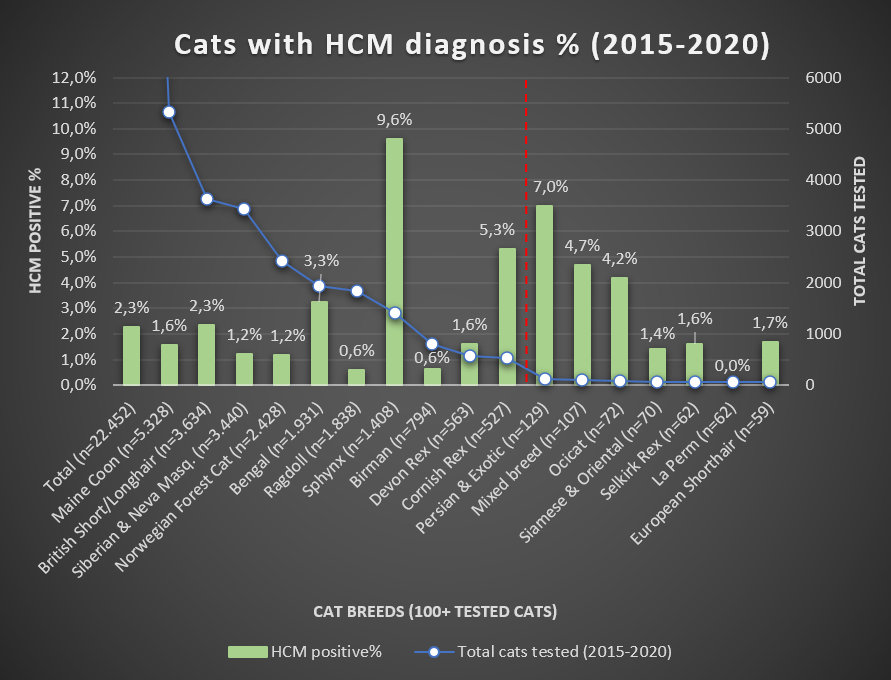
You can see from this recent chart that the total HCM cases have dropped for most breeds. To make the comparison easier to read, the next chart below will show you the progress for three different periods in time.
Progress of the Health program per breed
For each breed I have split the test results over three different periods in time:
-
all the test is done before 1-1-2010 (dark green bar)
-
the test that was done between 1-1-2010 and 31-12-2014 (green bar)
-
the test that was done between 1-1-2015 and 31-3-2020 (light green bar)
Within each time period, I have taken the population of cats that were tested in that period. I have counted the number of cats that were tested and the number of cats that got HCM diagnosed within that period. One cat can be counted in different time periods if the cat was retested in a different period.
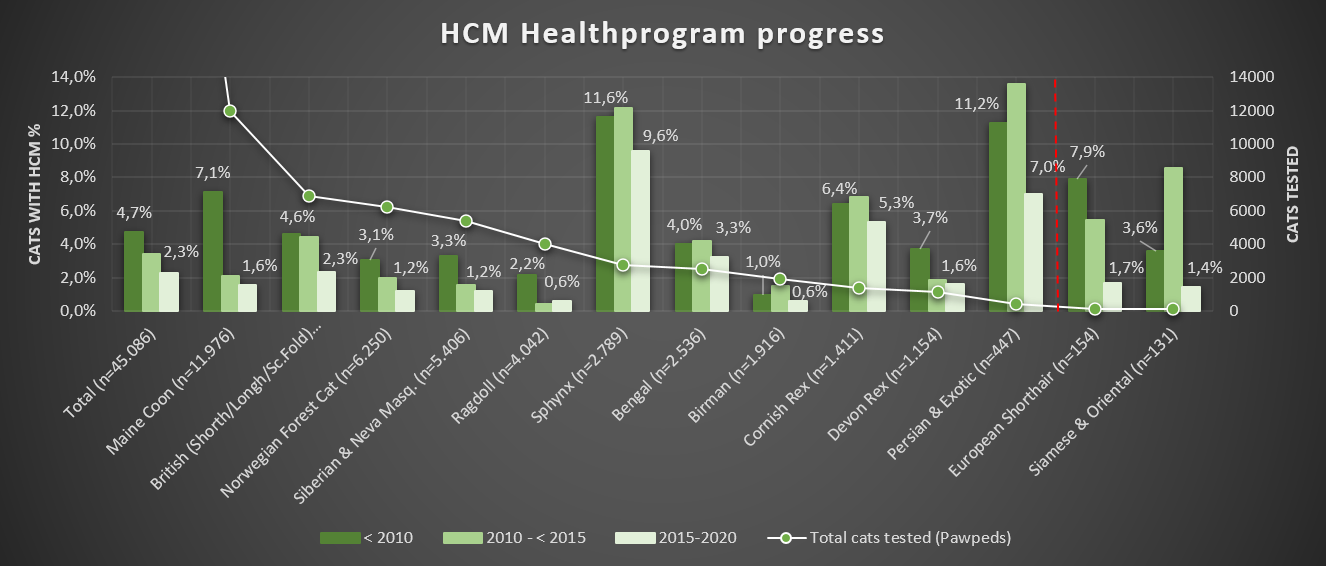
I have excluded the breeds that had less than 35 cats tested within each time period. For this Ocicat, Mixed breed, Selkirk Rex, and La Perm are excluded. The two breeds with medium reliable data are right from the red dotted line (Europian Shorthair and Siamese & Oriental).
The light green bar is the most recent bar showing the HCM diagnosed cats of the last five years. You can see that in most breeds the light green bar line shows fewer HCM cases than the dark green or green bar. Which shows an improvement. Only the Ragdoll didn't improve compared to the previous period, but it also has improved compared to the first period before 2010. All other breeds show good progress with less HCM diagnosed cats. The biggest improvement is shown at the Maine Coon, the Persian & Exotics, and the European Shorthair. There is a total improvement of 2,4% less HCM diagnosed cats for all shown breeds since the start of the breeding program.
In order to see if the health programs have a positive effect, a difference should be made in lines that are tested for multiple generations and new lines that have been tested for the first time. This data doesn’t show this difference, but gives you an overall picture of the total tested cats within the Health program. Still, you can see an overall improvement.
Question: how can we know for sure that the other cats (not diagnosed with HCM) didn't catch HCM later in life? How old were they first tested and were they tested again at a later age? At what age does HCM occur? At which age is the cat tested on HCM? Let's find out.
Age of test
First, let us take a look at what age a cat is tested. This chart shows the age of all HCM tests within the health programs. If a cat is tested for HCM multiple times, all these results are counted in the relevant age-groups. So this chart is based on the test results and not on the number of cats. The youngest cats (group 1, dark green) are tested before they were one year of age. The second group of test results shows the test results where the age of the cat was a minimum of 1 year old and less than 2 years old. And so on.
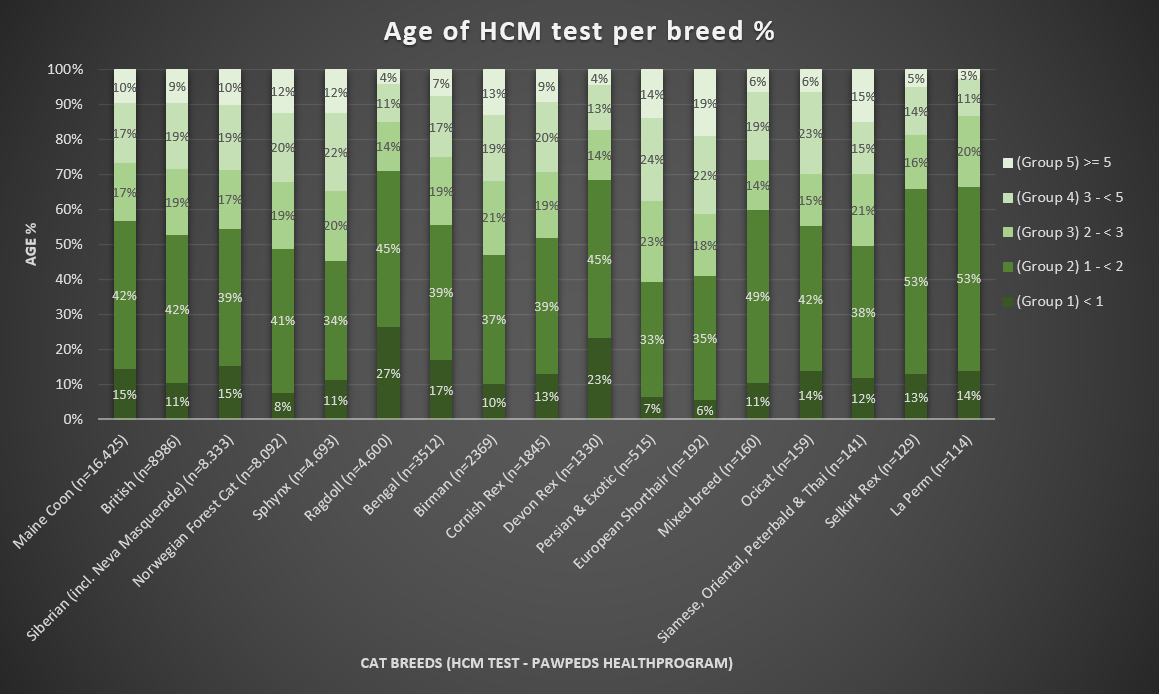
You can see that 72% of the Ragdolls are tested on HCM before their 2nd birthday, while only 40% of the Persian & Exotics are tested within that age group. Take this chart into consideration when looking at the previous charts again. It seems logical that breeds that have mostly very young cats tested, would have found fewer cases of HCM than if they would have tested their cats at an older age. For example, the Ragdoll showed only 0,6% HCM cases in the period of 2015-2020, but what would this result be if they tested their cats at the age of 5 years? At what age is HCM discovered?
The other way around, the Sphynx and the Persian & Exotic breed showed the highest percentage of HCM diagnosed cats. While you can see at this chart that they have tested their cats at an older age than the other breeds. 34% of the Sphynx was tested at 3 years or older and 38% of the Persian & Exotics were tested at 3 years or older, compared to only 15% of the Ragdoll. To analyze this further we need to know first at which age HCM starts to occur.
Age of the first diagnosis of HCM
This chart shows the first age where a cat is diagnosed with HCM. When a cat is retested at a later age with HCM again, this is not shown in the chart. Of course, we don’t know how long the cat already had HCM when he/she was tested. Some cats had a normal diagnosis before, but not all cats are tested multiple times. Some cats are tested for the first time at a later age and some cats are only tested normal at a young age and we don’t know what happened after. Still, I think this chart can give a good picture of when HCM reveals itself, because of the large amount of data available for some breeds.
I have added more age groups here, to view more specifically at which age most cats got an HCM diagnosis. The population that I have used for this chart is all the cats that got an HCM diagnosis (mild, medium, or severe). The breeds that are on the right side of the red dotted line are less reliable because of less available data.
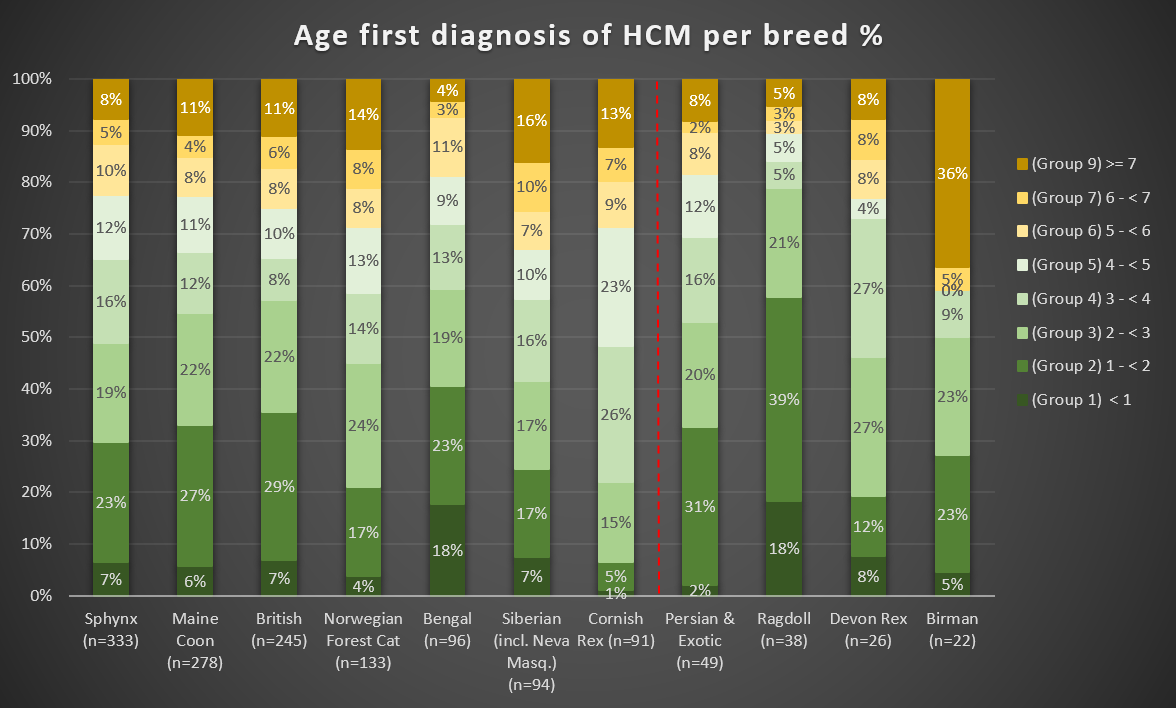
Let's look at the Birman breed. The Birman scored very well on the previous charts, with only 0,6% HCM diagnosed cats of all tested cats within the health program. In the previous chart, you could see that 13% of the Birmans were tested at age 5 or older. In this chart, however, you can see that 41% of the HCM diagnosed Birmans were diagnosed at the age of 5 or older. The test data shows only 22 Birmans with HCM, this might be too little to make conclusions. I do wonder how the first chart would look if the Birmans older than 5 years were (re)tested on HCM.
Let's look at the Cornish Rex. You see in the previous chart that 52% of the Cornish Rex cats are tested before they reach 2 years of age. In this chart however you see that only 6% of the HCM diagnosed Cornish Rex cats got that diagnosis at that same age. My question is: how useful is it to test a Cornish Rex before the age of 2?
PawPeds Health program test age recommendations:
The HCM health program of PawPeds recommends testing for HCM at age of 1, 2, 3, and 5 years. With important breeding cats or cats with elevated risks, another test at the age of 8 is recommended.
Is this a logical recommendation when we look at the total average of all breeds together (cumulative), showing at which age HCM is diagnosed:
-
7% of the cats that got HCM was first diagnosed before age 1
-
30% of the cats that got HCM were first diagnosed before age 2
-
51% of the cats that got HCM was first diagnosed before age 3
-
64% of the cats that got HCM was first diagnosed before age 4
-
76% of the cats that got HCM was first diagnosed before age 5
-
84% of the cats that got HCM was first diagnosed before age 6
-
89% of the cats that got HCM was first diagnosed before age 7
It looks that these guidelines are correct as every new age of testing gives enough percentage of risk that HCM still can occur when you retest.
But when you look at the different breeds separately, you do see differences in which age HCM can reveal itself. For some breeds, HCM seems to reveal itself at a much younger age than at other breeds. This could raise questions if the recommended test age applies to all breeds, or that we should look at each breed separately to advise recommended ages for HCM testing.
Testing cats on HCM that are 5 years or older
As mentioned before, most cats are tested at a young age and never got a retest at an older age. There might be more HCM hidden from the previous charts since we don't know if the cats who got a normal diagnosis would still have a normal heart at age 5. It would be interesting to see what the same chart would look like if we only counted the cats who were tested at age 5 or older, because of all the cats that develop HCM in life, 76% would be discovered before age 5. Those test results taken at that age are much more reliable, but on the other side, there aren't as many results as there are at younger ages. Still, some breeds like the Maine Coon, Norwegian Forest Cat, British short/longhair, Siberian, and Sphynx do have enough older cats tested to draw important conclusions.
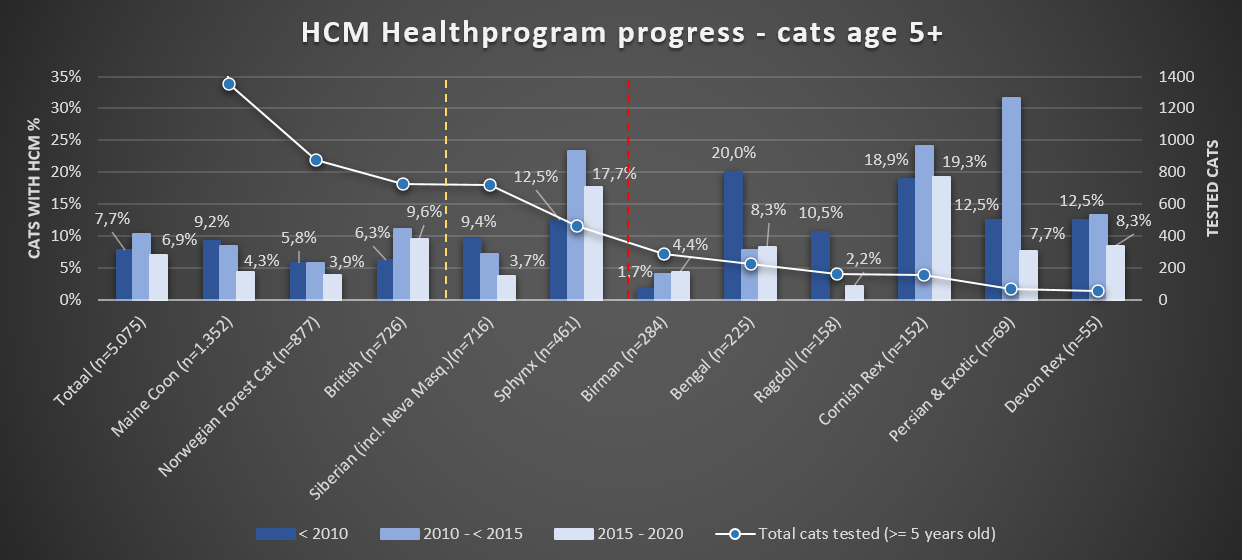
The number next to the breed indicates the total of cats that are tested at the age of 5 or older. (For example, the Bengal had 225 cats tested total over all three periods in time.) The breeds on the right side of the red dashed line shows less reliable results (less data). The two breeds between the yellow and red lines don't have reliable data for the first period <2010, but still have reliable data for the other two periods.
You can see here that some good progress is made with the Maine Coon (-4,9%), Norwegian Forest cat (-1,9%) and Siberian (-5,7%). The Sphynx and British short/longhair however, show an increase in cats with HCM.
Cats of all ages compared to cats tested at 5 years or older
The previous chart 7 showed that the last period (between 1-1-2015 and 31-3-2020) has the biggest number of cats tested at age 5 or older. The actual period is also the most interesting as it shows how many HCM cases we can expect nowadays for each breed. To make it easier to compare, I have taken the last period from Chart 7 again and compared it to the results of cats of all ages that was shown in Chart 3.
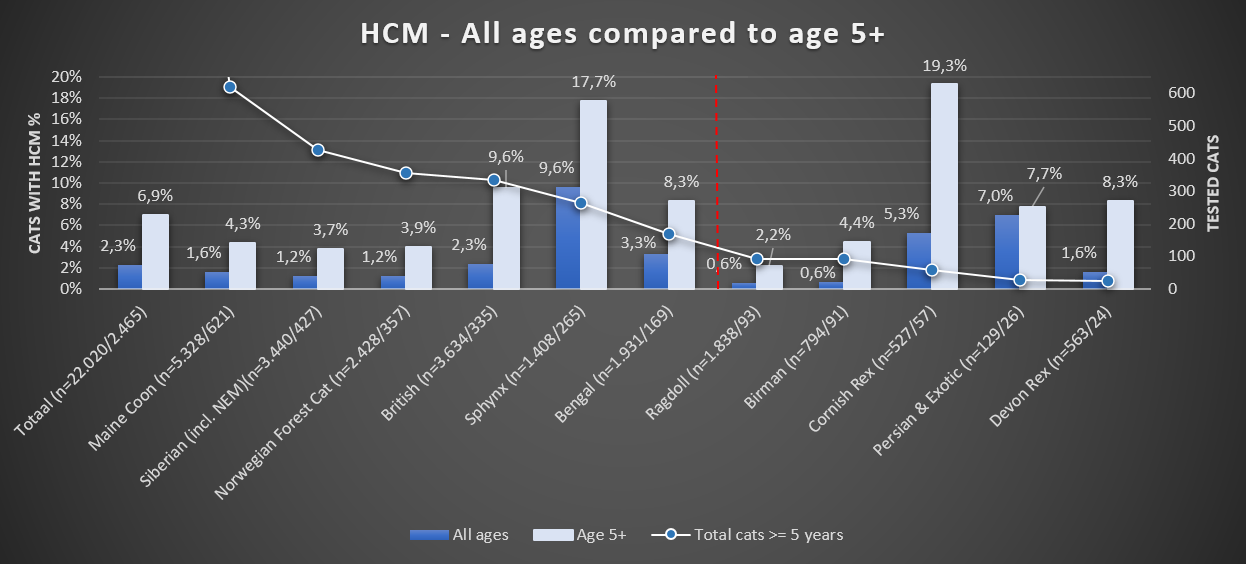
The number of cats that were in this population is shown behind the breed. For example, the Ragdoll had 1.838 Ragdolls tested of all ages, of which 0,6% showed HCM, and it has 93 Ragdolls tested of age 5 years or older, of which 2,2% showed HCM (2 cats).
As expected, every breed shows a lot more HCM diagnosed cats when you only count the cats that are tested at the age of 5 years or older. On average of all breeds, the HCM cases are 3 times as high (2,2% and 6,6%). Let's look at the Birman breed again. In the previous charts, this breed scored very well with very few HCM cases but most cats were tested at a young age. We see in this chart that when you look at the 91 Birman cats that were tested at 5 years or older, 4 cats (4,4%) were HCM diagnosed. Although 91 tested cats might not be enough to draw conclusions, it does show that age needs to be taken into consideration when looking at the previous charts. It is definitely clear that 1 HCM screening before the first litter is hardly enough. Retesting at an older age (5+) is very important and quite essential.
Considerations
Do these populations represent different breeds as a whole?
No, the population only consists of the cats that are tested within the Pawpeds HCM health program. The health program has specific requirements to ensure the quality of the test result. The only specialist who meets the requirements can participate with the program and only those testresults are accepted for registration. From these tested cats we get an honest picture, because the breeders signs for publication before the heart screening takes place and the specialist verifies the chip id of the cat. Which makes it very hard or impossible to cheat or to withhold bad results.
Why didn't we reach more significant progress when we have a health program for 20 years?
Some breeds have reduced the number of cats affected with HCM by half over time. Not all breeds have made significant progress though. The population that is used in this analysis is only a fraction of the total population of cats within that breed. We can see progress in the health program, but we don't know what's happening with the other cats. How fast and successful the health program is, depends highly on the participants. There is more work to do to find more breeders who are willing to participate and to screen their cats multiple times.
Another aspect is that these results might contain a lot of "new lines" with no track record yet that are added to the health database for the first time and could be at higher risk of HCM. This is what I want to look into more in the next part of this analysis.
To be continued...
It would be interesting to see if the progress is different in some countries, where more breeders participate in the health program. It would also be interesting to zoom in more into the inheritance of HCM by looking at multiple generations of tested cats. Another part of HCM testing is DNA testing on the MyBPC 3 gene. I am curious if this DNA test has a significant impact on the occurrence of HCM. Another aspect that I didn't cover here is the equivocal status. How many cats will get HCM after being diagnosed with equivocal? To make this article not too long I will try to cover these subjects in the next part.
By: Debbie Sprenger










